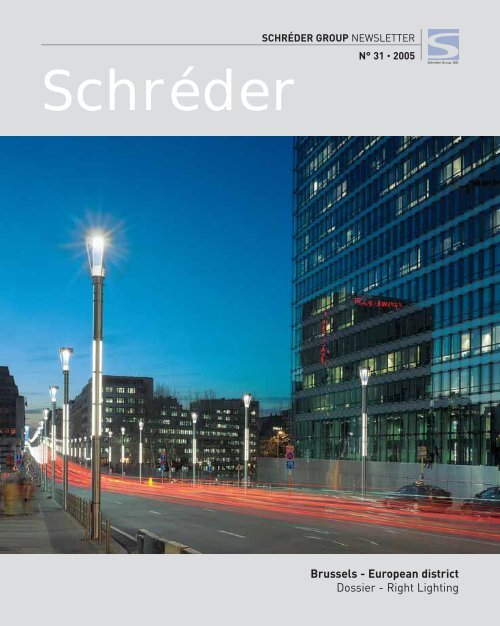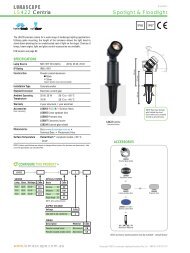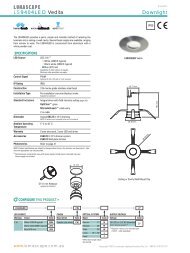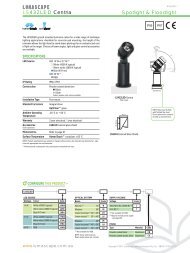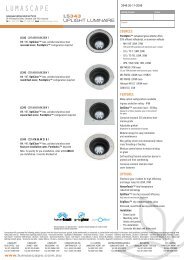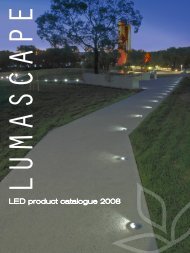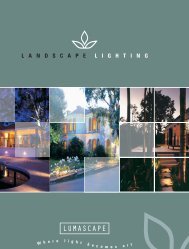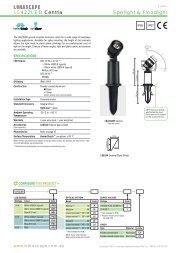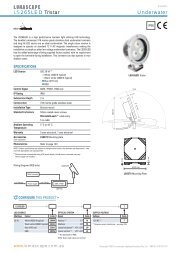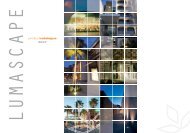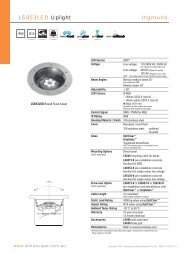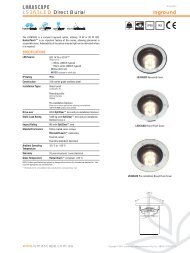Schréder - Lumascape
Schréder - Lumascape
Schréder - Lumascape
You also want an ePaper? Increase the reach of your titles
YUMPU automatically turns print PDFs into web optimized ePapers that Google loves.
SCHRÉDER GROUP NEWSLETTER<br />
N° 31 • 2005<br />
<strong>Schréder</strong><br />
Brussels - European district<br />
Dossier - Right Lighting<br />
<strong>Schréder</strong> N°31 • 2005 I 1
EDITORIAL<br />
<strong>Schréder</strong> News makes way for <strong>Schréder</strong>...<br />
<strong>Schréder</strong> Group GIE is delighted to present the first issue of <strong>Schréder</strong>. Up to now - and for many<br />
years already - we have brought you <strong>Schréder</strong> News. From now on, <strong>Schréder</strong> will be the official<br />
newsletter published by <strong>Schréder</strong> Group GIE.<br />
In addition to this change of name, there is also a new graphic style and a new, more practical<br />
and more readable format. In other words, this is a new information tool.<br />
The content has also evolved. While up to now <strong>Schréder</strong> News was mainly oriented towards the<br />
development of specific technical dossiers, <strong>Schréder</strong> will be more focused on what <strong>Schréder</strong><br />
Group GIE is and what it does here, in your country, but also in the forty or so member companies<br />
located on five continents.<br />
Nevertheless, the technical dossiers will still feature in the newsletter. In this first issue, we will<br />
focus on the problem of light pollution, which is increasingly being looked at by the authorities,<br />
the public and... lighting manufacturers. Since <strong>Schréder</strong> aims to be the number one reference<br />
in lighting, this status must naturally be justified by fundamental research. The study initialised<br />
by <strong>Schréder</strong> Group GIE’s Research & Development centre on light pollution is just one such<br />
example of this. The quality of the luminaires and the quality of the photometric studies are the<br />
essential elements that will allow us to effectively tackle the problem posed by light pollution.<br />
Our products and research departments throughout the world are in a position to respond to this<br />
in an optimal way.<br />
For several years now, the <strong>Schréder</strong> Group has positioned itself as a partner of the city.<br />
<strong>Schréder</strong> is not only a manufacturer of lighting equipment. <strong>Schréder</strong> listens to all the players<br />
concerned with the future direction to be given to the city, whether they are town planners,<br />
lighting designers, architects or the local authority staff responsible for the regeneration of the<br />
urban landscape.<br />
And light plays a full part in this urban (r)evolution. Out of its functionality, it becomes the<br />
creator of ambiance. Light also provides orientation and guidance, it highlights and enhances,<br />
and aids perception and safety... In short, light is a formidable tool! A tool that <strong>Schréder</strong> knows<br />
how to control perfectly. To direct the light precisely where it is wanted and needed, with care and<br />
respect. Respect for people whose dwellings must not be troubled by intrusive light. Respect<br />
for the night sky that light must not obliterate. Respect for the world's energy resources, whose<br />
consumption can be limited through the use of high photometric performance luminaires. It is<br />
with this mission that we commit ourselves and devote our efforts.<br />
At your side.<br />
As partners.<br />
Happy reading!<br />
Jean <strong>Schréder</strong><br />
Chairman - <strong>Schréder</strong> SA<br />
Comelec s.a.<br />
Export of <strong>Schréder</strong> products<br />
Rue de Lusambo 67<br />
B-1190 Brussels - Belgium<br />
Tel.: + 32 2 332 01 06<br />
Fax: + 32 2 332 22 32<br />
E-mail: comelec@comelec.be<br />
www.schreder.com<br />
Member of <strong>Schréder</strong> Group GIE<br />
<strong>Schréder</strong> Group GIE<br />
Rue de Lusambo 67<br />
1190 Brussels - Belgium<br />
Tel.: + 32 2 332 01 06<br />
Fax: + 32 2 332 22 32<br />
E-mail: general@schreder.be<br />
www.schreder.com<br />
Beka (PTY) Ltd<br />
13 West View Road - PO Box 120 –<br />
Olifantsfontein 1665<br />
South Africa<br />
Tel.: + 27 11 238 0000<br />
Fax: + 27 11 238 0180<br />
www.schreder.com<br />
Member of <strong>Schréder</strong> Group GIE<br />
www.schreder.com
DOSSIER – RIGHT LIGHTING<br />
Light, a new source of pollution? 4<br />
WHAT’S NEW<br />
Abahjur - A home-like atmosphere in town at night 11<br />
Modullum - A column with modular photometry<br />
Atos - A luminaire made from synthetic materials<br />
Onyx 2 ST - Maximised tightness level<br />
Eco 3 - Floodlights: range extended<br />
REFERENCES<br />
France - Millau viaduct: between heaven and earth 13<br />
Belgium - European district in Brussels<br />
Greece - A bridge to the Peloponnese<br />
South Africa - Luminous columns in the heart of Johannesburg<br />
Serbia & Montenegro - The Belgrade Arena: seen on TV!<br />
Brazil - 58,000 luminaires<br />
United States - A tunnel for Boston<br />
GROUP NEWS<br />
Collection catalogue 15<br />
INTEL 2005<br />
Spotlight on the LUCI cities in Liège<br />
TABLE OF CONTENTS<br />
<strong>Schréder</strong> N°31 • 2005 I 3
FEATURE<br />
LIGHT POLLUTION<br />
Report written by Jean-Charles Bogaert. <strong>Schréder</strong> Group Product Range Manager<br />
Light, a new source<br />
of pollution?<br />
After water and air pollution, should we now fear atmospheric pollution<br />
from light? A recurring theme in the debate on the future quality of<br />
our environment<br />
On a beautiful summer’s night, haven’t you<br />
often lamented the abundance of lighting<br />
preventing you from contemplating the<br />
Milky Way? An anarchic proliferation of<br />
advertising signs, a waste of energy and all<br />
sorts of pollution generated by badly<br />
designed public lighting... It’s a fact: badly<br />
used or excessive lighting can be a<br />
nuisance. Astronomers were the first to<br />
attract our attention to the problem, but the<br />
general public is also starting to make itself<br />
heard.<br />
In North America and Europe, committees are<br />
forming to demand that this problem be taken<br />
seriously. Astronomers are of course at the<br />
forefront of these demands, and in certain<br />
countries the authorities have passed laws<br />
regulating the use of lighting close to their<br />
observatories. The Czech Republic, Australia,<br />
the United States, Chile and Italy are also<br />
developing a legal arsenal against “light<br />
pollution”. And the United Kingdom could soon<br />
follow suit. However, the greatest caution is<br />
required if we are to avoid overly simplified<br />
laws that will only end up banning the most<br />
high performance equipment in terms of<br />
energy consumption.<br />
Light pollution or unwanted light?<br />
The word pollution refers to “damage to an<br />
area resulting from bad management of the<br />
environment or the introduction into this<br />
environment of pollutants (chemical,<br />
biological, urban or domestic waste)”. Is this<br />
a suitable definition for defining the problem<br />
4 I SCHREDER GROUP NEWSLETTER<br />
in hand? It is difficult to consider light in itself<br />
as a “pollutant”; it is rather an excess and<br />
bad use of it that makes it harmful. We would<br />
therefore prefer to use the term “unwanted<br />
light” to define a light that “attracts<br />
attention, is a source of bother and one we<br />
cannot escape even if we want to”.<br />
But is light always really the guilty party?<br />
Quite often, residents’ complaints focus on<br />
lighting for the sole reason that it is, by<br />
nature, very visible. In reality, the pollution<br />
attributed to it may have other causes, such<br />
as noise coming from a road, a car park or a<br />
sports ground. This problem should thus be<br />
approached in an overall manner, taking into<br />
account all its components, and in particular<br />
the surrounding area. It is clear that the<br />
problem cannot be resolved in the same way<br />
if the lighting installation in question is<br />
located right in the middle of a town centre,<br />
on the outskirts of a town or in a rural area.<br />
There is a hierarchy to be respected between<br />
these various sites. In certain sensitive areas,<br />
such as an airport for instance, lighting is<br />
major safety factor.<br />
Animals and plants as well...<br />
Unwanted light can be subdivided into several<br />
types of pollution for which it is necessary to<br />
find specific solutions. For instance, the night<br />
sky can be polluted by what is called a halo of<br />
light. This is caused by light emitted upwards,<br />
which illuminates the sky by reflecting on the<br />
particles suspended in the air (dust, water<br />
particles, etc.).<br />
A halo of light indicates the combination of<br />
two types of pollution: light emitted directly<br />
by the luminaire towards the sky - light<br />
shining directly upward - and light reflected<br />
by the surface to be lit - light reflecting<br />
upwards.<br />
The halo of light diminishes the contrast<br />
between the stars and the dark background<br />
of the sky, thus making it difficult,<br />
or even impossible, to make astronomical<br />
observations. In other words, it is not greatly<br />
appreciated by astronomers. Certain studies<br />
even aim to show that it could influence the<br />
natural cycle of animals or plants.<br />
Gefahr für die Augen !<br />
Another type of pollution is dazzling light<br />
caused by too great a contrast between the<br />
light source and the surroundings. This<br />
generally happens when the light shines<br />
directly and too intensely into the eyes. By<br />
shining directly into the eyes, the light limits<br />
the eyes’ ability to adapt to the dark, thereby<br />
making dark areas dangerous.<br />
Finally, the last type of pollution is intrusive<br />
light caused by an excess of light diffused by<br />
certain lighting installations towards areas<br />
where lighting is not desirable. It manifests<br />
itself in different ways, such as for instance<br />
the intrusion of exterior light directed<br />
towards windows of houses, disturbing the<br />
sleep or activities of the occupants.<br />
The solution: efficient optics<br />
What are the factors that cause a halo of light<br />
and how can they be prevented? To find out,<br />
Jean-François Laporte and Marc Gillet of<br />
<strong>Schréder</strong> Group GIE conducted a study on<br />
photometric performance.<br />
Their study, based on 175 photometric<br />
readings, combined a variety of parameters:<br />
type and power of the light sources, light<br />
distribution of the luminaires, shape of the<br />
luminaire protectors, configuration of the<br />
road, and the road surface. Their method: an<br />
analysis of the upward luminous flux emitted
Unwanted light is characterised by several sources of<br />
pollution: dazzling light, invasive light and a halo of<br />
light, which indicates the combination of two phenomena:<br />
light emitted directed by the luminaire towards<br />
the sky - light shining directly upwards - and light<br />
reflected by the surface to be lit - light reflecting<br />
upwards.<br />
Invasive light is an excess of light directed towards<br />
areas where it is not desirable.<br />
directly by the luminaire and indirectly by the<br />
reflection on the lit up roads and their<br />
surrounding area.<br />
86,000 calculations to avoid systematic use<br />
In total, they made more than 86,000<br />
photometric calculations. They were in<br />
particular able to demonstrate the variations<br />
in the upward luminous flux depending on<br />
the road surface and its surrounding area.<br />
To reduce the dispersion of the luminous<br />
flux towards the sky, they recommended<br />
optimising the photometric performance<br />
and the location of the luminaires. They<br />
emphasised that the luminaires equipped<br />
with a flat protector are not systematically<br />
the most suitable as regards light pollution.<br />
Those equipped with a slightly curved<br />
protector are better in some cases.<br />
Consequently, no permanent obligation to<br />
use flat protectors!<br />
The secrets of a good luminaire<br />
In fact, we always come back to the number<br />
one question: optimising the optics. It is only<br />
by endeavouring to do so that we will be able<br />
to successfully prevent light pollution. The<br />
research carried out by <strong>Schréder</strong> has<br />
demonstrated the following: a good luminaire<br />
is one that manages to optimally use the<br />
luminous flux emitted by the lamp in order to<br />
precisely focus on the area to be lit.<br />
Luminaires designed for “precise lighting”<br />
should therefore be used.<br />
Precise lighting, against unwanted light<br />
and for sustainable development<br />
However, these “clean” luminaires not only<br />
make it possible to prevent unwanted light,<br />
they also allow for a reduction in the number<br />
of luminaires and the power of the lamps.<br />
The result: significant energy savings, which<br />
remains a major concern for sustainable<br />
development issues.<br />
Keyword: efficiency<br />
Light shining directly upwards<br />
Useful light<br />
Potentially dazzling light<br />
Surface to be lit<br />
Efficiency is the keyword to come out of this<br />
study. It is also the objective that <strong>Schréder</strong><br />
has set itself within the framework of its<br />
Research & Development activities, and it is<br />
an objective we will undoubtedly achieve<br />
thanks to our photometric developments and<br />
our research department. It is these<br />
departments and this know-how that make a<br />
difference with regard to photometric<br />
FEATURE<br />
LIGHT POLLUTION<br />
Light reflecting upwards<br />
Invasive light<br />
Seen from the sky, the phenomena likely to cause unwanted light are clearly concentrated in geographical areas with<br />
the highest level of economic and industrial development.<br />
efficiency. More than ever before, they are<br />
responsible for <strong>Schréder</strong>’s position as THE<br />
reference in lighting.<br />
<strong>Schréder</strong> N°31 • 2005 I 5
FEATURE<br />
LIGHT POLLUTION<br />
What are the different types of protector?<br />
Deep protector<br />
One of the main parameters the study<br />
takes into account is the shape of the<br />
protector: flat, slightly curved or deep. For<br />
6 I SCHREDER GROUP NEWSLETTER<br />
Slightly curved protector<br />
each of these models, the quantity of light<br />
emitted upwards has been calculated by<br />
varying the type and power of the source, as<br />
Shape of the protector:<br />
no simplistic answer or systematic use<br />
With the deep protector, there is a significant luminous<br />
flux shining directly upwards towards the sky. But<br />
thanks to a large space between the poles - made<br />
possible by a better use of the lumens emitted by each<br />
lamp - there is a lower number of luminaires and a<br />
reduction in the reflected luminous flux.<br />
It is important to emphasise that a luminaire<br />
with a flat protector positioned horizontally<br />
is not automatically the best solution to limit<br />
the total luminous flux shining upwards.<br />
With the slightly curved protector, there is less<br />
luminous flux shining upwards towards the sky.<br />
However, because the space between the poles is<br />
smaller, the reflected light flux increases.<br />
This clearly shows that we cannot always<br />
recommend the same type of luminaire, and<br />
that the best solution requires a specific study<br />
that takes into account all the environmental<br />
parameters.<br />
Flat protector<br />
well as the nature of the road surface and the<br />
surrounding area.<br />
With the flat protector positioned horizontally, there is<br />
no luminous flux shining directly upwards, but because<br />
there is a smaller space between the poles, the<br />
reflected flux is greater and the total power of the<br />
installation is much higher.<br />
A compromise has to be found between the<br />
total installed power and the luminous flux<br />
emitted upwards. This depends on a great<br />
number of factors and requires a specific indepth<br />
study.
The importance of efficient photometry<br />
Total luminous flux shining upwards<br />
Flux lumineux ascensionnel total<br />
(lumens/km)<br />
(lumens/km)<br />
100000<br />
90000<br />
80000<br />
70000<br />
60000<br />
50000<br />
40000<br />
30000<br />
20000<br />
10000<br />
0<br />
20 30 40 50 60 70<br />
Average number of lumens required to obtain<br />
Nombre moyen de lumens nécessaires pour obtenir<br />
1cd/m 2<br />
2<br />
1cd/m sur 1 m de chaussée<br />
2 on 1 m2 of road (asphalt surface)<br />
Asphalt, grass<br />
Asphalte, Pelouse<br />
Asphalt,<br />
Asphalte, grey paving<br />
Pavement gris<br />
Béton, Pelouse<br />
Concrete,<br />
Béton, grey paving<br />
Pavement gris<br />
Deep Protecteur protector plan<br />
Slightly Protecteur curved profond protector<br />
Flat Protecteur protector légèrement bombe<br />
Road surface and the nature of the surrounding<br />
area are significant factors<br />
Concrete, grass<br />
Dual carriageway, unilaterally lit, at (?) cd/m 2<br />
0 10 20 30 40 50 60<br />
Total luminous flux shining upwards (kilolumens/km) depending on<br />
the surface of the road and the surrounding area.<br />
Flux ascensionnel direct<br />
Flux shining directly upwards<br />
Flux ascensionnel réfléchi<br />
par la chaussée<br />
Flux shining upwards<br />
reflected by the road<br />
Flux ascensionnel réfléchi<br />
par les abords<br />
Flux shining upwards<br />
reflected by the surrounding<br />
area<br />
FEATURE<br />
LIGHT POLLUTION<br />
This diagram shows that the total luminous<br />
flux shining upwards (direct and reflected) is<br />
directly proportional to the average number of<br />
lumens required to obtain the desired<br />
luminance on the road. This means that if we<br />
manage to reduce the number of lumens<br />
installed while maintaining the same level of<br />
luminance, the total luminous flux shining<br />
upwards will decrease proportionally<br />
regardless of the type protector.<br />
In short, it is therefore the photometric<br />
efficiency of the installation that will lead to<br />
a reduction in unwanted light.<br />
We have noted that with asphalt, the total flux<br />
shining upwards is reduced by half compared<br />
to when concrete is used.<br />
Furthermore, the flux shining upwards<br />
reflected by grass is more than halved<br />
compared with the flux reflected by grey<br />
paving.<br />
It is interesting to note that the road surface<br />
and the nature of the surrounding area are<br />
two significant factors which contribute to<br />
the reflected luminous flux emitted<br />
upwards.<br />
<strong>Schréder</strong> N°31 • 2005 I 7
FEATURE<br />
LIGHT POLLUTION<br />
Examples for inspiration<br />
Illuminating from the ground<br />
The Terra Maxi and Midi floodlights are the<br />
ideal tools for the upward lighting of façades,<br />
monuments, trees, etc. When equipped with a<br />
suitable reflector, it is possible to control the<br />
light without unnecessarily dispersing the flux.<br />
Photometric accessories on floodlights to guide the flux<br />
The new ranges of floodlights developed by<br />
<strong>Schréder</strong> - for instance, Focal and Neos - take<br />
into account the concern for precise lighting<br />
An old design is not an antique<br />
Integrating high-performance<br />
optics into an old-fashioned<br />
street lamp is possible. The<br />
optics direct the light with<br />
precision onto the place to be<br />
lit: road, path, car park, etc.<br />
while the optical compartment<br />
forms a watertight unit accessible<br />
via a plug. The Sealsafe ® system<br />
provides the luminaire with an IP66<br />
tightness level during the whole of<br />
its lifetime. This system prevents any<br />
accumulation of dust inside the<br />
8 I SCHREDER GROUP NEWSLETTER<br />
Thanks to its asymmetrical optics, this façade lighting can be recessed in the ground without being inclined, while<br />
directing the luminous flux towards the façade and minimising dispersion towards the sky.<br />
thanks to a wide range of accessories that<br />
direct the luminous flux where it is required.<br />
protector, diffusing the light in all<br />
directions. It remains clean and does<br />
not hinder the dispersion of the<br />
luminous flux, an advantage that also<br />
makes it possible to limit the<br />
power of the lamps since the<br />
loss of light is minimised.<br />
The use of louvres, a light channel or a visor make it<br />
possible to direct the luminous flux towards the area to<br />
be lit.
Solutions for lighting large areas<br />
Lighting for sports grounds or large areas<br />
(car parks, storage areas, airports, etc.)<br />
requires numerous high-power floodlights<br />
placed high up.<br />
The most simple solution would be to incline<br />
the floodlights so that the luminous intensity<br />
peak is at the desired angle, but this has been<br />
shown to cause light pollution. This is why<br />
<strong>Schréder</strong> developed Alisios, a highly<br />
asymmetrical floodlight that offers a<br />
maximum luminous intensity angle of 60°<br />
while maintaining the floodlight in a<br />
horizontal position, thus preventing a direct<br />
flux upwards.<br />
Urban luminaires respectful of residents<br />
The luminaires in the Citéa, Maya and Scala<br />
ranges can be equipped with louvres that<br />
limit invasive light directed towards housing.<br />
In this luminaire for lighting towns and roads, the louvres<br />
have been integrated into a Sealsafe ® optical compartment<br />
in order to limit invasive light directed at<br />
facades situated behind the luminaire. Their inclusion<br />
in the optical compartment prevents them from becoming<br />
dirty.<br />
FEATURE<br />
LIGHT POLLUTION<br />
The Alisios floodlight aims to meet concerns regarding<br />
efficiency as well as limiting flux shining directly<br />
upwards.<br />
<strong>Schréder</strong> N°31 • 2005 I 9
FEATURE<br />
LIGHT POLLUTION<br />
Examples not to follow!<br />
Globes are a no-no!<br />
Globe-shaped luminaires devoid of any optical<br />
system whatsoever and shining light in all<br />
directions are a good example of what should<br />
be avoided under all circumstances!<br />
However, one-fifth of the decorative lighting<br />
installations in France are equipped with this<br />
type of luminaire.<br />
While “globe lighting” may be one of the classics when<br />
it comes to decorative lighting in our urban landscape,<br />
it is nevertheless a horrible source of unwanted light!<br />
<strong>Schréder</strong> has developed several luminaires inspired by<br />
this basic form by equipping them with high-quality<br />
optics that are more respectful of the environment.<br />
GENERAL GUIDELINES TO LIMIT<br />
UNWANTED LIGHT:<br />
[1] Make sure the floodlight receives regular<br />
maintenance and that the exterior surface<br />
of the protector is regularly cleaned. Dust<br />
can modify light distribution by increasing<br />
the overall diffusion of the light.<br />
10 I SCHREDER GROUP NEWSLETTER<br />
[2] Do not “over-light” by respecting the<br />
existing standards as closely as possible.<br />
[3] Soon, electronic intensity dimmers will<br />
allow operators to precisely adjust the light<br />
emitted by a luminaire depending on the<br />
levels of lighting required.<br />
In the Canaries, the<br />
stars shine more<br />
brightly<br />
Wide open spaces, a clear sky nearly all year<br />
round, a very thin atmospheric layer...all these<br />
are conditions sought after by astronomers.<br />
Hardly surprising then that they decided to set<br />
up shop in the Canaries! And it is no surprise<br />
either that these islands are leaders in the fight<br />
against halos!<br />
In 1988, the Spanish government promulgated a<br />
law relating to the protection of astronomical<br />
observations, finalised by a royal decree in<br />
March 1992. An office for the protection of sky<br />
quality in the Canaries (O.T.P.C. - Oficina<br />
Técnica para la Protección de la Calidad del<br />
Cielo) was also created in January 1992. Its aim<br />
is to control and assess the various activities<br />
which could hamper observations.<br />
These laws (*) control both outdoor lighting and<br />
anything that could disturb the astronomical<br />
observations, such as industrial emissions,<br />
exhaust fumes from planes or radio signals.<br />
In particular, they specify that luminaires for<br />
lighting roads cannot be inclined and cannot<br />
emit light upwards. They must also be equipped<br />
with a double lamp system or a system to vary<br />
the lamp’s intensity allowing the luminous flux<br />
to be reduced after midnight by at least two<br />
thirds of the initial power, without having a<br />
negative effect on uniformity.<br />
The light from the floodlighting on public<br />
buildings, monuments and advertising boards,<br />
and light from the lighting in parks or sports<br />
grounds must always be emitted downwards.<br />
Furthermore, these types of lighting must be<br />
switched off by midnight at the latest.<br />
Nevertheless, social life does not appear to<br />
suffer from this drastic legislation. A list of<br />
authorised lighting devices has been<br />
established by the IAC (Instituto de Astrofísica<br />
de Canarias), and <strong>Schréder</strong> luminaires are<br />
among the most highly rated.<br />
(*) the two legal texts are available at<br />
www.iac.es/proyect/otpc/docum.htm<br />
The Isaac Newton observatory on the site of Roque de<br />
los Muchachos on the island of La Palma. Sources:<br />
website of the “Instituto de Astrofísica de Canarias”:<br />
http://www.iac.es/
Atos<br />
A luminaire made from synthetic materials<br />
Atos is a new, recently developed luminaire for<br />
public lighting applications combining savings<br />
in capital costs and high photometric<br />
performance. This luminaire, with its assertive<br />
design, is almost entirely constructed using<br />
synthetic materials with obvious anti-corrosive<br />
properties. While robust in its design, Atos is<br />
nevertheless light in weight. The Atos<br />
luminaire offers a remarkable tightness level<br />
both with regard to the optical compartment,<br />
with the Sealsafe® system ensuring a longlasting<br />
IP 66, and the IP 54 control gear<br />
compartment. This luminaire, which is<br />
equipped with an inclination system, can be<br />
used in all types of environments.<br />
Onyx 2 ST<br />
Maximised tightness level<br />
A new design line is now available in the Onyx<br />
range. The Onyx 2 ST has a very high tightness<br />
level: Sealsafe ® IP 66 for the optical<br />
compartment and IP 65 for the control gear<br />
compartment. The Onyx 2 ST can be fitted<br />
with lamps of up to 250 W.<br />
The Onyx 2 ST, a public lighting solution with a very<br />
high tightness level.<br />
To meet the particular needs of the installation, Atos<br />
can be inclined on site. There are five positions<br />
available, from - 5° to +5°.<br />
Eco 3<br />
Floodlights: product range extended<br />
Composed of aluminium and glass, the Eco3<br />
completes our range of floodlights. Offering a<br />
wide choice of reflectors and lamps of up to 400<br />
W, this economical floodlight particularly suits<br />
floodlighting or lighting for industrial zones,<br />
sports installations or car parks. Its tightness<br />
The Eco 3, a multi-purpose floodlight for lighting or floodlighting.<br />
WHAT’S NEW<br />
Made entirely from synthetic materials, Atos can be<br />
equipped with lamps of up to 150 W.<br />
level is IP65. Various photometric accessories<br />
such as louvres or visors complete the<br />
multipurpose character of this floodlight.<br />
<strong>Schréder</strong> N°31 • 2005 I 11
WHAT’S NEW<br />
Abahjur<br />
A home-like atmosphere in town at night<br />
An original design in outdoor urban lighting,<br />
the Abahjur luminaire is a fun element that<br />
helps to create atmosphere in towns.<br />
Abahjur can be equipped with a coloured<br />
protector and / or lampshade. It comes<br />
equipped with a metal halide lamp with a<br />
ceramic arc tube (coated elliptical) of up to<br />
12 I SCHREDER GROUP NEWSLETTER<br />
150 W. The development of this new<br />
luminaire has particularly taken into account<br />
the necessity of limiting the dispersion of<br />
upward luminous flux.<br />
Abahjur is a totally new design for lighting town centres and is specifically designed to create a pleasant atmosphere. In<br />
white or colour, Abahjur clearly associates creative and functional lighting.<br />
Modullum<br />
A modular photometric<br />
column<br />
The Modullum columns are characterised by<br />
their flexibility as regards photometry based<br />
on the diversity of modular optical compartments.<br />
According to the type of environment<br />
and the size of the column (Micro, Mini, Midi or<br />
Maxi), it is possible to select a model with 1, 2,<br />
3 or 4 modules, each with a distinct photometric<br />
function: lighting avenues, pavements,<br />
foliage, roundabouts or urban signposting.<br />
Depending on the model and type of optical<br />
compartment chosen, Modullum can incorporate<br />
metal halide lamps with a ceramic arc<br />
tube and high-pressure sodium of up to 150 W,<br />
or compact fluorescent lamps of up to 18 W.<br />
Modullum is available in four sizes: from a luminous<br />
post to a big urban column 9.50 metres high.<br />
360°
France<br />
Millau viaduct:<br />
between heaven and earth<br />
Designed by Norman Foster, the 2,460<br />
metres of this bridge that soar between heaven<br />
and earth provide a continuous route between<br />
Clermont-Ferrand and Montpellier in<br />
the South of France. This record-breaking<br />
masterpiece and brilliant vessel sailing 270<br />
metres high is lit by Comatelec, a member<br />
company of <strong>Schréder</strong> Group GIE.<br />
The supports and the tollbooths were lit and floodlit<br />
by Comatelec.<br />
Belgium<br />
European district in<br />
Brussels<br />
The Imperia columns created by Patrick<br />
Rimoux are made from steel. A luminaire at<br />
the top of the columns lights the road while a<br />
light-conducting cylinder made from acrylic<br />
lights the pavement. Only white sources are<br />
used.<br />
More than a hundred Imperia columns were installed on<br />
one of the main roads leading to the centre of the Belgian<br />
capital, in the heart of the European district.<br />
South Africa<br />
Luminous columns in the heart of Johannesburg<br />
BEKA, our member company in South Africa,<br />
has developed and delivered nearly<br />
400 luminous columns to light up<br />
Constitution Hill as part of the renovation<br />
effort in this area of Johannesburg. These<br />
columns rely on the particular expertise of<br />
BEKA in the domain of manufacturing poles<br />
in reinforced fibreglass, which optimises<br />
aesthetic aspects and presents a high degree<br />
of rigidity.<br />
The column has an optical compartment<br />
integrated into the top of the unit for a 150 W<br />
metal halide lamp. The optional translucent<br />
part of the column is equipped with a 100 W<br />
metal halide lamp. These columns are<br />
available in two sizes: 5.5 or 6.5 metres.<br />
The new South African constitutional court, as well as<br />
new tourism and cultural infrastructures, are located<br />
on Johannesburg’s Constitution Hill. It is on this<br />
prestigious site that our member company installed<br />
400 luminous columns.<br />
Greece<br />
A bridge to the<br />
Peloponnese<br />
REFERENCES<br />
As a result of the major works for the Olympic<br />
Games, the Peloponnese is now linked to the<br />
Greek mainland by a suspension bridge. The<br />
Rio Anterio bridge, located in one of the most<br />
seismically active regions of Europe and<br />
required to resist earthquakes of more than 7<br />
on the Richter scale, has been equipped with<br />
Tage units. Nearly 170 inclined masts, identical<br />
to those installed on the famous Vasco de Gama<br />
bridge in Lisbon, light this 3 km long bridge.<br />
The Peloponnese is now linked to Greece by a 3 km<br />
long bridge, lit by Tage units with inclined masts, giving<br />
it unique perspective and volume.<br />
<strong>Schréder</strong> N°31 • 2005 I 13
REFERENCES<br />
Serbia & Montenegro<br />
The Belgrade Arena:<br />
seen on TV!<br />
The Belgrade Arena is the third largest<br />
sports hall in Europe. Inaugurated on 30 July,<br />
the Arena has a surface area of 48,000 m 2<br />
and can hold 20,000 spectators.<br />
<strong>Schréder</strong> not only lit this immense multisports<br />
hall but also all the new access roads<br />
and the surrounding areas.<br />
The lighting solution implemented met the<br />
strictest criteria defined by the international<br />
competition sports associations for high<br />
definition television broadcasting. Light is an<br />
essential element for ensuring quality<br />
television pictures, all the more so for high<br />
definition television as well as for slowmotion<br />
pictures.<br />
Besides the high levels of luminance<br />
achieved, the lighting solution offers a very<br />
high level of visual comfort thanks to<br />
excellent uniformity (with no shadows) and no<br />
glare whatsoever. With its 82 RS and 162<br />
Zenith floodlights installed, all equipped with<br />
2000 W metal halide lamps, the Arena is<br />
Brazil<br />
58,000 luminaires<br />
<strong>Schréder</strong> do Brasil has been awarded a<br />
contract for 58,000 luminaires from the Opalo<br />
United States<br />
A tunnel for Boston<br />
Cut in two by an unsightly highway overpass<br />
since the 1950 s , Boston has now become<br />
one again thanks to a tunnel that replaced<br />
the elevated highway after 13 years of works.<br />
Before the tunnel, Boston was a disfigured city cut in two<br />
by an elevated urban highway.<br />
14 I SCHREDER GROUP NEWSLETTER<br />
The Belgrade Arena, a gigantic sports hall re-lit by <strong>Schréder</strong> to meet the stringent requirements of high definition<br />
television.<br />
already considered the best lit sport megatemple<br />
in Europe!<br />
The Opalo range has 2 models for lamps of up to 250 W.<br />
This range of economic luminaires with high photometric<br />
performance seduced Brazil!<br />
range in the state of Espírito Santo, for delivery<br />
by the end of the year.<br />
This 850-metre long tunnel, with a capacity<br />
for 245,000 vehicles a day, was lit by<br />
our Canadian company using nearly 2,500<br />
luminaires equipped with either fluorescent<br />
After the tunnel was built, Boston found its integrity<br />
once again. The north and south of the city are no longer<br />
separated.<br />
or high pressure sodium lamps.<br />
The Boston tunnel: new proof of <strong>Schréder</strong>’s know-how<br />
in tunnel lighting.
Intel 2005<br />
After Frankfurt, Madrid and Paris, <strong>Schréder</strong> will<br />
be present at the Intel 2005 fair which will be<br />
held in Milan from 17 to 21 May. This will be a<br />
new opportunity to demonstrate our know-how<br />
in urban photometry and show our extended<br />
range of urban and ambient lighting as well as<br />
our first complete ranges of street furniture.<br />
Collection catalogue Spotlight on the LUCI cities in Liège<br />
The catalogue Urban Lighting Collection<br />
features more than twenty new lighting units<br />
which all stand out thanks to their assertive<br />
design, their high photometric performance<br />
and the quality of the materials used. All these<br />
units confirm that <strong>Schréder</strong> is the perfect<br />
partner for towns and cities.<br />
A Street Furniture catalogue has also been<br />
published which showpieces the harmonious<br />
integration of luminaires and street furniture<br />
through the presentation of several ranges of<br />
equipment.<br />
To obtain a copy, do not hesitate to contact the<br />
<strong>Schréder</strong> Group GIE company present on your market.<br />
This year in Milan, <strong>Schréder</strong> will highlight the diversity<br />
of urban applications - as it did in Frankfurt - which its<br />
range of luminaires can cater for thanks to the wide<br />
range of photometry it has developed.<br />
LUCI, four letters that stand for “Lighting<br />
Urban Community International”, an<br />
association that includes various cities from<br />
around the world, from Lyon to Bologna, and<br />
from Ouagadougou to Shanghai, involved in<br />
optimising urban spaces using quality<br />
UPCOMING TRADE FAIRS<br />
Milan - Intel: from 17 to 21 May 2005<br />
Lyon - Lumiville: from 31 May to 2 June 2005<br />
Porto/Exponor - Endiel: from 11 to 15 October 2005<br />
GROUP NEWS<br />
lighting. As the official sponsor of this<br />
association, <strong>Schréder</strong> Group GIE welcomed<br />
the members of LUCI at its general meeting,<br />
which took place in Liège on 1 October.<br />
With Mr Jean <strong>Schréder</strong> as their host, nearly 100 representatives from LUCI’s member cities visited the installations at<br />
<strong>Schréder</strong> Group GIE’s Research & Development Centre in Liège on 1 October.<br />
<strong>Schréder</strong> N°31 • 2005 I 15<br />
doppio.be • 1671
34303<br />
in the city at night, feel at home...<br />
16 I SCHREDER GROUP NEWSLETTER<br />
<strong>Schréder</strong>, the urban light<br />
ALEXANDRIA | BASINGSTOKE (UK) | BELGRADE | BEIRUT | BOISBRIAND (CA) | BRUSSELS |<br />
BUDAPEST | LISBON | LES CULLAYES (CH) | MADRID | MILAN | MOSCOW | NEW DEHLI | PARIS |<br />
PRETORIA | PRAGUE | RHENEN (NL) | SAO PAULO | SANTIAGO | STUTTGART | TIANJIN | WARSAW | WIEN<br />
www.schreder.com<br />
Creating an ambiance<br />
As an original outdoor urban<br />
lighting concept, the Abahjur<br />
luminaire is a tool you can play<br />
with to create ambiance in the city.<br />
In white and in colour<br />
The Abahjur may be fitted with<br />
protectors and/or coloured shades.<br />
It can be equipped with metal<br />
halide lamps with ceramic arc tube<br />
(coated elliptical) of up to 150 W.<br />
Particular care has been paid to<br />
minimising the upper hemispherical<br />
luminous flux.


